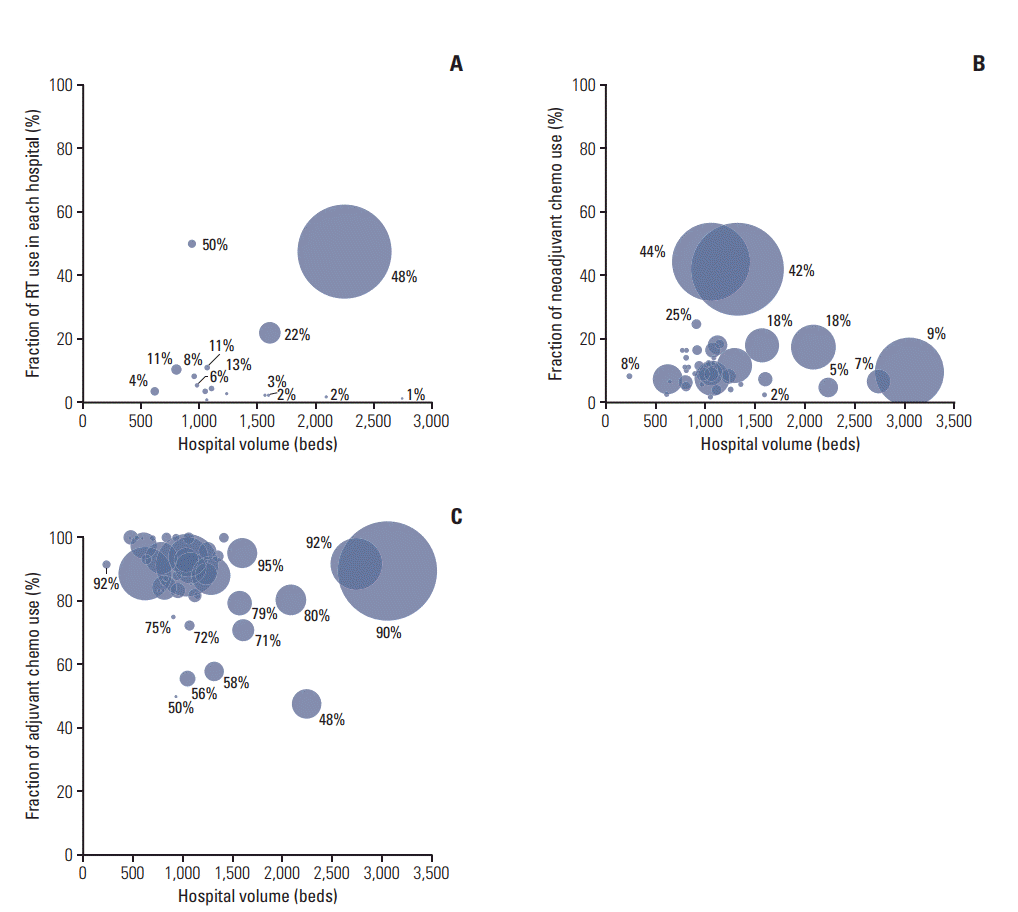글로벌 연구동향
방사선종양학
- [Cancer Res Treat.] Patterns of Care for Radiotherapy in the Neoadjuvant and Adjuvant Treatment of Gastric Cancer: A Twelve-Year Nationwide Cohort Study in Korea.
연세의대 / 장지석, 금웅섭*, 박은철*
- 출처
- Cancer Res Treat.
- 등재일
- 2018 Jan
- 저널이슈번호
- 50(1):118-128.
- 내용
Abstract
PURPOSE:
Although Korea has the highest incidence of gastric cancer worldwide and D2-lymphadenectomies are routinely performed, radiotherapy (RT) practice patterns have not been well studied. Therefore, we examined RT usage trends for neoadjuvant/adjuvant patients and identified factors associated with RT. We also examined survival benefits and net medical cost advantages of adding RT.
MATERIALS AND METHODS:
Patients diagnosed with gastric cancer who underwent gastrectomy from 2002-2013 were identified using National Health Insurance Service-National Sample Cohort.
RESULTS:
Annually, 30.9 cases per 100,000 population in crude rate underwent gastrectomy in 230 hospitals and 49.8% received neoadjuvant/adjuvant therapy in 182 hospitals. For neoadjuvant/adjuvant patients, postoperative chemo-RT was administered in 4% of cases in 26 hospitals. No significant trends regarding treatment type were observed over time. Having undergone RT was inversely associated with being ≥ 60 years old and having a low income. Having undergone RT was positively related to having a Charlson comorbidity index ≥ 4, hospital location and hospital volume (≥ 2,000 beds). Significant portions of patients treated with RT in this nation (52%) were concentrated in one large-volume hospital. Use of RT linked to increased cost of primary treatment, yet not to reduced overall medical expense. RT did not influence both on overall and disease-specific survivals after adjusting for potential confounders (p > 0.05).
CONCLUSION:
RT was uncommonly utilized as adjuvant or neoadjuvant treatment by physicians in Korea. Despite intrinsic drawback in this data, we did not find either survival benefit or net medical cost advantage by adding RT in adjuvant treatment.

Fig. 1.
Bubble charts for the proportion of patients by the hospital. Two-dimensional bubble charts indicate how the proportions of adjuvant chemoradiotherapy (A), neoadjuvant chemotherapy (B), and adjuvant chemotherapy use (C) in each hospital change by hospital volume. The size of the bubble corresponds to the proportion within each treatment group. RT, radiotherapy.병원 별 방사선 치료 사용 빈도에 대한 버블 차트.
치료 환자의 대부분은 국내 한 개의 대형병원에 집중되어 있으며, 전반적으로는 그 사용이 제한적인 상황입니다.
Author information
Chang JS1, Choi Y2,3, Shin J3,4, Kim KH1,5, Keum KC1, Kim HS6, Koom WS1, Park EC3,4.
1 Department of Radiation Oncology, Yonsei Cancer Center, Yonsei University College of Medicine, Seoul, Korea.
2 Department of Public Health, Graduate School, Yonsei University, Seoul, Korea.
3 Institute of Health Services Research, Yonsei University College of Medicine, Seoul, Korea.
4 Department of Preventive Medicine, Yonsei University College of Medicine, Seoul, Korea.
5 Graduate School of Medical Science and Engineering, Korea Advanced Institute of Science and Technology, Daejeon, Korea.
6 Division of Medical Oncology, Department of Internal Medicine, Yonsei Cancer Center, Yonsei University College of Medicine, Seoul, Korea.
- 키워드
- Adjuvant radiotherapy; Chemoradiotherapy; Physicians’ practice patterns; Stomach neoplasms
- 연구소개
- 위암은 대륙별로 수술 전후 보조적 치료가 다양한 암 종입니다. 위암에서 방사선 치료는 높은 근거 수준으로 효과가 입증이 된 보조치료이지만 D2 림프절절제술이 보편화된 아시아 국가에서 현재 치료 행태가 어떤 지에 대한 역학자료가 부족한 상태라 본 연구를 계획하게 되었습니다. 국민 건강보험자료 DB를 이용하였고, 2002년부터 2013년까지 국내에서 위암으로 진단받고 근치적 수술을 시행 받은 환자 중 보조적 치료를 받은 환자를 분석하였습니다. 국내 총 230개 병원에서 10만명당 연 30.9명의 위암 환자를 수술하며, 이 중 49.8%에서 보조적 치료를 시행 되는데, 이 중 방사선 치료가 포함된 수술 후 항암 방사선 치료는 전체 26개 병원에서 보조 치료 환자 중 전체 4%의 환자에서만 시행되고 있었다는 것을 확인하였습니다. CCI가 높아서 Full-dose 항암 치료가 어려울 것 같은 환자에서 방사선 치료를 많이 시행하는 경향을 보였고, 치료 환자의 대부분은 국내 한 개의 대형병원에 집중되어 있으며 그 외 병원에서는 사용이 되지 않음을 확인하였습니다. 항암 치료에 대한 evidence가 확립된 2007년을 기준으로 이 시기 전후의 보조적 항암 치료 사용 행태를 봤을 때, evidence가 정립되기 전에도 보조적 항암 치료는 대부분의 병원에서 흔하게 사용되고 있는 반면, 방사선 치료는 evidence가 발표된 2001년 이후에도 그 사용이 증가하는 경향성을 보이지 않았습니다.
- 덧글달기
- 이전글 [J Breast Cancer.] Selective Radiation Therapy for Ductal Carcinoma In Situ Following Breast-Conserving Surgery According to Age and Margin Width: Korean Radiation Oncology Group 11-04 and 16-02 Studies.
- 다음글 [Radiat Oncol J.] Controversial issues in radiotherapy for rectal cancer:a systematic review.










편집위원
보험공단 자료를 이용하여 위암에서 방사선치료 현황과 이득을 분석한 논문으로, 향후 다양한 원발부위에 대한 연구 가능성을 제시해 주고 있습니다.
2018-02-07 11:42:24